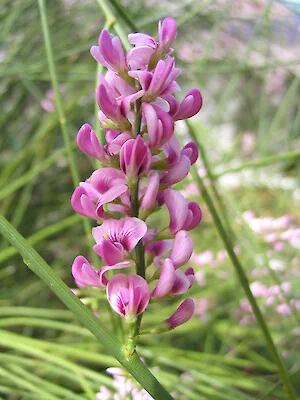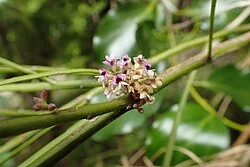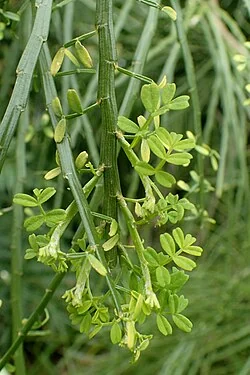
Native Broom
Carmichaelia glabrescens
Explore more NZ native plant guides in our index .
Introduction
About Slender Broom
Carmichaelia glabrescens , commonly known as Native Broom, is a slender, leafless shrub endemic to New Zealand's South Island, distinguished as Pink Broom by its distinctive slender, drooping, green compressed branchlets and beautiful pink pea-like flowers that bloom from November to January. This remarkable South Island endemic reaches up to 7 m tall in optimal conditions, specifically distributed in Marlborough south of the Awatere Fault where it has adapted to challenging environments including alluvial terraces, gorges, cliff faces, and steep valley sides from lowland to montane elevations. Characterized by its spreading to upright growth habit and linear, laterally compressed seed pods containing 2-3 seeds that mature from January through December, this nitrogen-fixing legume requires full sun and excellent drainage while being intolerant of heavy shade and humidity. Its specialized ecological niche and specific regional distribution make it a prized addition to specialist native plant collections, particularly valued for its stunning seasonal flowering display and architectural form that enhances native garden landscapes with authentic South Island character.

Plant Description
Carmichaelia glabrescens , commonly known as Native Broom or Pink Broom, is a slender, leafless shrub endemic to New Zealand's South Island. It is characterized by its distinctive slender, drooping, green compressed branchlets that function as leaves, an adaptation to dry environments. This shrub can grow up to 7 meters tall and produces beautiful pink pea-like flowers from November to January. These are followed by linear, laterally compressed seed pods containing 2-3 seeds. It thrives in full sun and excellent drainage, typically found on alluvial terraces, gorges, cliff faces, and steep valley sides in the Marlborough region.
Quick Facts
Shrub Summary
| Scientific Name | Carmichaelia Glabrescens |
|---|---|
| Height | 1-2 m |
| Spread | 0.5-1 m |
| Water Needs | Low; very drought-tolerant |
| Light | Full sun to partial shade |
| Frost Tolerance | High |
| Salt Tolerance | Moderate |
| Growth Rate | Moderate |
| Lifespan | Perennial |
Climate Best Suited to
Carmichaelia glabrescens is found throughout New Zealand in a variety of habitats, specifically adapted to South Island environments from lowland to montane zones, naturally establishing on alluvial terraces, dramatic gorges, cliff faces, and steep valley sides in the distinctive Marlborough region south of the Awatere Fault. This specialized endemic thrives in New Zealand's South Island climate, demonstrating exceptional tolerance for challenging free-draining sites while requiring protection from humidity and heavy shade, making it ideal for sunny, well-ventilated positions that replicate its natural cliff and terrace habitats.
Regional Suitability
| Whangārei | Ideal |
| Auckland | Ideal |
| Hamilton | Suitable |
| Rotorua | Suitable |
| Tauranga | Ideal |
| Gisborne | Ideal |
| New Plymouth | Ideal |
| Whanganui | Ideal |
| Palmerston North | Suitable |
| Napier | Ideal |
| Wellington | Ideal |
| Nelson | Ideal |
| Christchurch | Suitable |
| Dunedin | Suitable |
| Invercargill | Suitable |
| City | Climate Suitability |
|---|
Habitat
Natural Distribution
Carmichaelia glabrescens , commonly known as Pink Broom or Slender Broom, is an endemic shrub to the South Island of New Zealand, specifically found in the Marlborough region northwards from Kaikoura and south of the Awatere Fault. It thrives in lowland to montane areas, demonstrating its adaptability to various elevations.
Its natural habitat includes alluvial terraces, gorges, cliff faces, and steep valley sides. This species is well-adapted to challenging conditions, tolerating dry, windy environments and frost. It grows quickly in sunny, rocky areas and prefers free-draining soil. It is intolerant of heavy shade and humidity, which are key factors in its distribution and growth patterns. As a nitrogen-fixing legume, it contributes to soil fertility in these often-harsh environments.
Plant Conservation
Carmichaelia glabrescens is an endemic New Zealand species with a restricted distribution in the Marlborough region of the South Island, found south of the Awatere Fault. This specialized geographic range makes the species particularly significant for regional biodiversity conservation efforts in the Marlborough area.
The species benefits from its adaptation to challenging environments including alluvial terraces, gorges, cliff faces, and steep valley sides, which provide some protection from widespread habitat modification. However, its restricted range makes it potentially vulnerable to localized threats and environmental changes within its limited distribution area.
Conservation efforts benefit from the species' successful cultivation potential, as it is easily propagated from fresh seed and can be established on steep, free-draining banks and rock walls. This cultivation success provides opportunities for conservation through habitat restoration and ex-situ preservation of genetic material.
As a nitrogen-fixing legume, Pink Broom plays an important ecological role in improving soil fertility in harsh dryland environments. Its conservation value extends beyond the species itself to include its contribution to ecosystem health and its role as an indicator of the condition of specialized Marlborough dryland habitats. Ongoing monitoring of populations within its restricted range helps ensure the long-term survival of this regionally endemic species.
Growing Requirements
Soil Requirements
Prefers well-drained, fertile soil with good organic content. Tolerant of a wide range of soil types, including sandy and clay soils.
Light Requirements
Grows best in full sun to partial shade.
Water Requirements
Requires consistent moisture, especially during dry periods. Once established, it is drought-tolerant.
Planting Guide
-
When to Plant
Plant in autumn or spring.
-
Site Preparation
Choose a sunny or partially shaded site with well-drained soil.
-
Planting and Aftercare
Dig a hole twice the width of the pot. Place the plant in the hole and backfill with soil. Water well and apply a layer of mulch.
Ecological Significance
Carmichaelia glabrescens , also known as Pink Broom or Slender Broom, holds significant ecological importance, particularly within New Zealand's montane ecosystems. This endemic shrub or small tree plays several crucial roles in its specialized habitat.
- Pioneer Species and Soil Improvement: It acts as a vital pioneer species, colonizing very steep, unstable slopes, alluvial terraces, gorges, cliff faces, and steep valley sides where few other plants can establish. As a member of the legume family (Fabaceae), it performs nitrogen fixation, enriching poorly developed soils and preparing sites for other montane plants. This ability to improve soil conditions is critical for ecosystem development in challenging environments.
- Habitat Creation and Support: By colonizing these difficult terrains, Carmichaelia glabrescens contributes to habitat creation, supporting diverse wildlife communities. Its unique adaptation to these environments makes it a foundational species in these specific niches.
- Adaptation to Challenging Environments: The plant is remarkably adapted to New Zealand's montane conditions, thriving in full sun and free-draining soils. It tolerates drought, wind, and coastal exposure, making it resilient in harsh environments. Its slender, drooping bright green branchlets perform photosynthesis in place of traditional leaves, showcasing a unique adaptation to minimize water loss.
- Pollinator Support: The exquisite pink flowers with dark pink veins, appearing from November to January, attract specialized native pollinators, including native bees, contributing to local biodiversity.
- Seed Dispersal: Seeds are possibly dispersed by wind and granivory (seed consumption by animals), aiding in its spread across suitable habitats.
- Conservation Status: While previously declared "Near threatened" in 2006 by IUCN criteria, it was declared "not threatened" under the New Zealand Threat Classification System in 2018 and remains "Not Threatened" as of 2023. Despite this, its restricted range and specialized habitat requirements make it important for conservation attention and genetic diversity preservation. Threats include browsing animals, habitat modification, and climate change.
Uses and Significance
Garden Uses
- An excellent plant for rock gardens, borders, and coastal areas.
- Its leafless stems and pea-like flowers make it a charming addition to any landscape.
Cultural Significance
Traditional Uses and Values
Carmichaelia glabrescens , also known as Pink Broom or Smooth Broom, holds significance primarily within the ecological and botanical context of New Zealand, contributing to the country's natural heritage.
- Endemic Heritage: It is a unique component of New Zealand's native legume flora, showcasing specialized adaptation to challenging montane environments. This makes it a distinctive part of the country's natural evolutionary history.
- Ecological Role: As a nitrogen-fixing member of the legume family, Carmichaelia glabrescens plays a vital role in improving soil quality and establishing pioneer vegetation. It thrives in difficult terrains like alluvial terraces, gorges, cliff faces, and steep valley sides, where few other plants can grow, thus contributing to ecosystem health and stability.
- Botanical Interest: The species is part of the diverse Carmichaelia genus, which is unique to New Zealand, making it of interest to botanists and conservationists studying the country's flora.
- Horticultural and Restoration Value: It is valued for its use in native gardens, dry landscapes, and coastal plantings due to its attractive pink flowers, architectural green stems, and drought tolerance. It is also widely utilized in ecological restoration projects for its resilience and environmental benefits.
Landscaping Uses
Garden Design Applications
Carmichaelia glabrescens , also known as Pink Broom or Slender Broom, is a versatile New Zealand native shrub with several valuable landscaping applications due to its hardiness, unique appearance, and ecological benefits.
- Native Gardens and Restoration Projects: It is ideal for native gardens and widely used in restoration projects, particularly in montane ecosystems, due to its resilience and ecological benefits. It acts as a pioneer species, contributing to nitrogen fixation and soil stabilization in challenging environments.
- Challenging Environments: This plant thrives in dry landscapes, coastal plantings, and difficult sites, tolerating drought, wind, frost, and poor, free-draining soils. Its adaptability makes it a robust choice for areas where other plants struggle.
- Erosion Control: Carmichaelia glabrescens is excellent for slope stabilization, making it suitable for steep banks, retaining walls, cliff faces, and rock walls. Its root system helps to bind soil and prevent erosion.
- Ornamental and Architectural Features: Its slender, green stems provide a unique architectural appearance, and it produces attractive clusters of pink to mauve pea-like flowers in summer (November to January in New Zealand), adding colour and attracting pollinators.
- Specific Garden Styles: It is well-suited for rock gardens, alpine, and montane-themed plantings, where its natural habitat can be replicated. It can also be used for screening, around ponds, and in pool areas.
- Low Maintenance: Once established, it is extremely hardy and requires minimal intervention, making it an easy-to-grow option for various garden styles and for gardeners seeking low-maintenance solutions.
Seasonal Care Calendar
Spring
- Apply a balanced fertilizer and a layer of mulch.
Summer
- Water regularly, especially during dry periods.
Autumn
- No special care required.
Winter
- Protect from heavy frosts in colder regions.
Pruning and Maintenance
Minimal Care
Remove any old, damaged, or yellowing stems as needed to maintain the plant's appearance.
Prune Native Broom lightly to maintain structure; remove damaged shoots and avoid hard cuts on older wood.
How to Grow Native Broom
From Seed
Raise Carmichaelia glabrescens readily from seed. Collect mature pods in late summer to autumn and extract the small, hard seeds typical of New Zealand brooms. Improve germination by scarifying: either nick the seed coat lightly with a file or pour hot (not boiling) water (~80°C) over the seeds and soak for 12-24 hours until swollen. Sow on a very free-draining seed-raising mix, just covered (2-3 mm), and keep evenly moist at 15-22°C in bright, airy conditions. Germination often starts within 2-6 weeks but may be staggered. Prick out promptly into individual tubes to protect the developing taproot, and use a gritty, low-fertility mix. Because Carmichaelia species form nitrogen-fixing symbioses with rhizobia, using a native-friendly mix or a small amount of local soil can assist early nodulation and vigorous growth. Harden off before planting and choose full sun with very sharp drainage, reflecting the dry, rocky habitats this species comes from.
From Semi-Hardwood Cuttings
Take firm semi-hardwood cuttings 6-10 cm long from current-season growth in late spring through summer. Reduce lower side shoots, retain a small tuft at the tip, and cut just below a node. Apply a rooting hormone (IBA 0.3-0.8%) and insert into a very free-draining medium such as 1:1 perlite and coarse sand. Provide bottom heat (18-22°C) and high humidity without prolonged leaf wetness; maintain excellent ventilation and bright, indirect light. Keep the medium barely moist. Rooting may take 8-12+ weeks; pot on carefully into a gritty, fast-draining mix and gradually acclimatise. Establish outdoors only in full sun and well-drained sites; overwatering and poor drainage are the most common causes of failure.
Pests and Diseases
Resilient Nature
Generally pest and disease free.
Watch for scale and fungal leaf spots; improve airflow and avoid over-watering to limit disease pressure.
Bonus Tip
Expert Growing Advice
Carmichaelia glabrescens , also known as Pink Broom, is a fascinating New Zealand native with several unique adaptations. It's one of the few plants that can colonize very steep, unstable slopes, acting as a pioneer species that prepares sites for other montane plants. Its leafless branchlets perform photosynthesis, reducing water loss, and its nitrogen-fixing ability allows it to thrive in very poor soils. During summer, it produces exquisite pink flowers with dark veins that attract specialized native pollinators. If you're considering growing Carmichaelia glabrescens , ensure it's planted in full sun and very well-drained soil, mimicking its natural montane habitat. It tolerates dry, windy conditions and frost but is intolerant of heavy shade and humidity.







